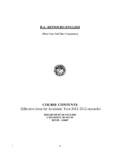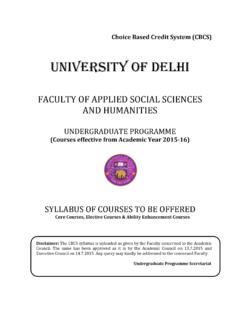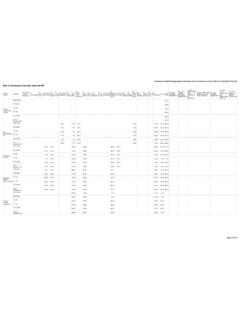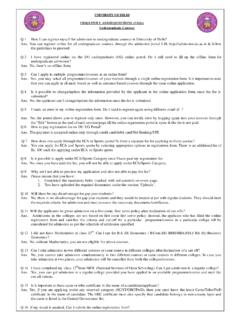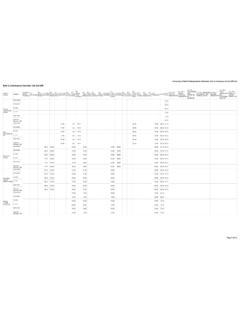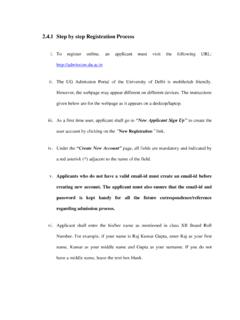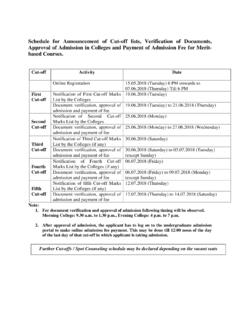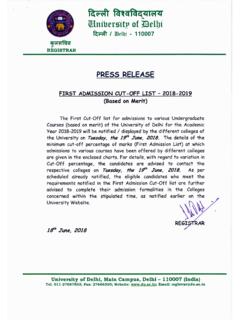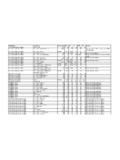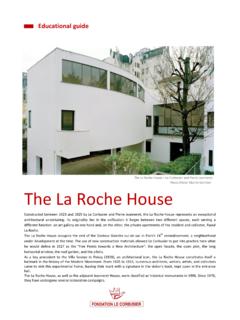Transcription of B.A. PROGRAMME - University of Delhi
1 PROGRAMME . DISCIPLINE COURSE. HISTORY. COURSE CONTENTS. (Effective from the Academic Year 2011-2012 onwards). DEPARTMENT OF HISTORY. University OF Delhi . Delhi . 1. PROGRAMME (DISCIPLINE COURSE). HISTORY. SEMESTER. I History of India upto c. 300 Cultures in the Indian Subcontinent --I. II History of India c. 300 to Eighth Century Cultures in the Indian Subcontinent --II. III History of India III (8th to 18th Century)/. Cultural Transformation in early Modern Europe I (c. 1500-1800). IV History of India IV (8th to 18th Century)/. Cultural Transformation in early Modern Europe II (c. 1500-1800). V History of India V (c. 1750s- 1970s)/. Issues in the World History I (The 20th Century). VI History of India VI (c. 1750s- 1970s)/. Issues in the World History II (The 20th Century). 1. Students opting for History as part of the PROGRAMME are expected to do Six papers out of a total of Twelve. 2. In each year they can choose among Four papers. However each students must take up at least Two Non Indian History papers over the three years, Cultural Transformations in Early Modern Europe- I (c.)
2 1500-1800) and Cultural Transformations in Early Modern Europe II ( ) Or Issues in World History: The Twentieth Century I and Issues in World History: The Twentieth Century II. 2. PROGRAMME . SEMESTER I. HISTORY OF INDIA UP TO C. 300 1. Survey of sources and Historiographical Trends; Regions, Environment and People and their significance for understanding early India. 2. Palaeolithic and Mesolithic Cultures: Sequence and Geographical distribution rock-art. 3. Advent of food-production; Neolithic Cultures. 4. Harappan Civilization: Origin and extent, political and economic organization art and religion. Decline and Late Harappan Cultures;. Chalcolithic cultures outside and Harappan distribution zone. 5. Society, polity, economy and Religion as reflected in Vedic Literature. The Arya Problem; Iron Age Cultures with special reference to PGW and Megaliths. 6. Development from sixth to fourth centuries : rise of territorial states emergence of cities, social and material life, new religious movements.
3 Suggested Readings: Agrawal, The Archaeology of India Alichin, and B Origins of a Civilization: The Prehistory and Early Archaeology of South Asia Basham, The Wonder That was India Chakrabarti, Archaeology of Ancient Indian Cities Jaiswal, Suvira Caste: Origin, Function and Dimensions Sharma, Perspective in Social and Economic History of Early India Subramanian, N. Sangam Polity Thapar, Romila History of Early India 3. SEMESTER I. CULTURES IN THE INDIAN SUBCONTINENT - I. Definitions of Culture and its various aspects. (i) Perspective on Cultures : Indian Cultural tradition: An overview. (ii) Plurality of Cultures: Social Content of Culture 1. Language and Literature Sanskrit: Kavya - Kalidasa's Ritusambhara: Prakrit: Gatha Saptasati, Development of vernacular language and literature; Indo-Persian Literature: Amir Khusro's works: Urdu poetry and prose: Ghalib. 2. Performing Arts a) Hindustani, (b) Carnatic classical Music, (c) Devotional music: bhakti and sufi: - Classical and Folk Dance - Theatre: Classical, Folk, Colonial and Modern 3.
4 Architecture: Meanings, form and Function (a) Rock-cut-Mamallapuram (b) structural temple architecture- Khajuraho complex and Tanjavur temple; (c) fort Dalulatabad or Chittor forts; (d) palace-dargah at Fatehpur Sikri; (e) colonial Lutyen's Delhi . SUGGESTED READINGS : Asher Catherine, (ed.): Perceptions of India's Visual Past, AIIS, Delhi , 1994. Asher Catherine, Architecture of Mughal India Basham , The Wonder that was India. Volume I, New Delhi Brown Percy, Indian Architecture, Buddhist Hindu and Islamic, Vol. I, II, Mumbai, 1956. Chandra Prainod, ed, Studies in Indian Temple Architecture; Chapter 1. AIIS, 1975. Deva, , An introduction to Indian Music, Delhi , 1973. Maxwell, , Image: Text and Meaning: Gods of South Asia, OUP, Delhi Tillotson G, Havelis of Rajasthan. Zimmer, H., Myths and Symbolism in Indian Art and Civilization, Princeton Press, New Jersey, Cohn. Bernard, India: The Social Anthropology of a Civilization in Bernard Cohn Omnibus, OUP, 2004. Vatasayana Kapila; Indian Classical Dance, Publications Divisions, New Delhi , 1974 (in Hindi Translation also).
5 4. SEMESTER II. HISTORY OF INDIA C. 300 TO EIGHTH CENTURY 1. Survey of sources and Historiographical Trends. 2. The Mauryan Patterns: state, administration and economy, Ashoka's Dhamma, art and architecture. 3. Post-Mauryan Patterns: Social, economic, political and cultural (literature: religion, art and architecture) developments with special reference to India's external trade and cultural interactions; Sangam Age literature, society and culture. 4. The Guptas and their contemporaries: state and administrative institutions, social and economic changes, religion, art and architecture, literature. 5. Towards the Early Medieval: Changes in society, polity, economy and culture with special reference to the Pallavas, Chalukyas and Vardhanas. * Rubrics 2 to 5 should taught with reference to recent studies on gender, caste and property relations. Suggested Readings: Chatopadhyay, B. Kushan State and Indian Society Gonda, J. Vishnuism and Shivaism: A Comparison Huntington, The Art of Ancient India Jha, Ancient India in Historical Outline (1998 edn.)
6 Kosambi, Culture and Civilization of Ancient India in Historical Outline Kulke H. and A History of India Rothemund, D. Ray, Monastery and Guild Ray, Niharranjan Maurya and Post Maurya Art Sastri, A History of South India Sharma, Aspects of Political Ideas and Institutions in Ancient India (1991 edn.). Thapar, Romila Ashoka and the Decline of the Mauryas (1997 edn). Yazdani, G. Early History of Deccan 5. SEMESTER II. CULTURES IN THE INDIAN SUBCONTINENT II.. 1. Perceptions of visual Past and Present 2. Sculpture and Painting (a) Silpashastric normative tradition: (b) Classicism Narrative and Sculptural, Mural fresco paintings: (c) post Classicism Pallava Cola; (d) medieval idiom . Mughal paintings, painters and illustrated texts: (e) Modern company school, Ravi Varma, Bengal School, Amrita Shregil and Progressive Artists. 3. Popular Culture - Folk Lore and Oral tradition of Kathas, narratives, legends and proverbs, Linkages of bardic and literary traditions. - Festivals, fairs and fasts; Links with tirtha, pilgrimage and localities.
7 - Textile and Crafts; the Culture of Food. 4. Communication, Patronage and Audiences - Court Merchant groups and communities. - Culture as Communication. - Nationalism and the issue of Culture; Institutions of Cultural Practices Colonial and Post Colonial. SUGGESTED READINGS : K. T. Achaya, A Historical Dictionary of Indian Food , OUP. Banerjea : The Development of Hindu Iconography, Calcutta, 1956. Bussagli M and Srivaramamurthy C.: 5000 Years of Indian Art, New York, History and Culture of the Indian People, Bharatiya Vidya Bhavan Series. Huntington Susan L: The Art of Ancient India, Tokyo New York, 1985. Kramrisch, Stella, The Art of India, Orient Book Depot. Delhi , 1987. Miller Barbara Stoler: The Powers of Art: Patronage in Indian Culture, OUP, Delhi 1992. Mitter Partha: Much Maligned Monsters, Oxford, 1977. Mitter Partha: Art and Nationalism in Colonial India, OUP, Delhi . Mukherji: Folk Art of India Ramanujsan, , Collected Papers OUP. Richman, Paula, Many Ramayanas OUP.
8 Rizvi, : The Wonder that Was India: Volume II., New Delhi . Varadpande of Indian Theatre: Invitation to Indian Theatre, New Delhi , 1987. Traditional Indian Theatre: Multiple Streams, Hindi translation: Paramparik Bharatiya Rangmanch: Anant Dharayed NBT, New Delhi 1995. 6. SEMESTER III. HISTORY OF INDIA III (8th to 18th CENTURY). 1. Characterizing Early Medieval India. 2. Social and economic conditions in India 8th- 12th Centuries; Evolution of Political structures of Rashtrakutas, Palas, Pratihars, Cholas and Rajput. 3. Indian Merchants in Overseas Trade (8th 15th Centuries). 4. Arabs in Sind: Polity Religion and Society. 5. A Survey of religious and cultural developments including Tantricism and Nathpanhis. 6. Evolution of regional styles in art and architecture. 7. Foundation, Expansion and Consolidation of the Delhi Sultanate; North West Frontier and the Mongols. 8. Military, administrative and economic reforms under the Khaljis and the Tughlaqs. 9. Sultanate Nobility and the working of iqta system.
9 10. Bhakti and Sufi Movements, 7. SUGGESTED READINGS: R. S. Sharma : Indian Feudalism B. D. Chattopadhaya : Making of Early Medieval India Derryl N. Maclean : Religion and Society in Arab Sindh K. M. Ashraf : Life and Conditions of the People of Hindustan M. Habib and Nizami : A Comprehensive History of India, Tapan Ray Chaudhary : The Cambridge Economic History of India, and Irfan Habib (ed.). Peter Jackson : Delhi Sultanate: A Political and Military History Tara Chand : Influence of Islam on Indian Culture Satish Chandra : A History of Medieval India, 2 Volumes Percy Brown, : Islamic Architecture 8. SEMESTER III. CULTURAL TRANSFORMATION IN EARLY MODERN EUROPE I (c. 1500 1800). Key Concepts and Historical Background (a) The Idea of Early Modern; Perspectives on Culture in History (b) An overview of the Classical and Medieval Legacy 1. The Renaissance (a) Society and Politics in Italian City States (b) Humanism in Art and Literature (c) Developments in Science and Philosophy (d) Renaissance beyond Italy 2.
10 Upheaval in Religion (a) Papacy and its critics (b) The spread of Protestant sects in Northern Europe (c) Counter Reformation and religious strife (d) The economic and cultural impact of the Reformations 3. The Conquest of the New World: Material, Social and Cultural Aspects 9. BASIC READING: 1. Illustrated Histories of Europe and / or the World such as Margaret King : A Social and Cultural History, Ralph and Lerner, Norton & Co. New York / London; Zaller and Greavres, Harper & Row Publications, New York: W. Burns, History of Civilisations, (Indian Reprint); Marvin Perry, Houghton Miffin Co., Boston etc. 2. Relevant chapters on religion, education, literature and the arts in Koenigsberger and Mosse, Europe in the Sixteenth Century Pennington, Europe in the Europe in the Seventeenth century and Anderson, Europe in the Eighteenth Century, (All published by Longman). 3. Peter Burke, Popular Culture in Early Modern Europe 4. John Berger, Ways of Seeing 5. Relevant Chapters in Norman Davis Europe 6.

